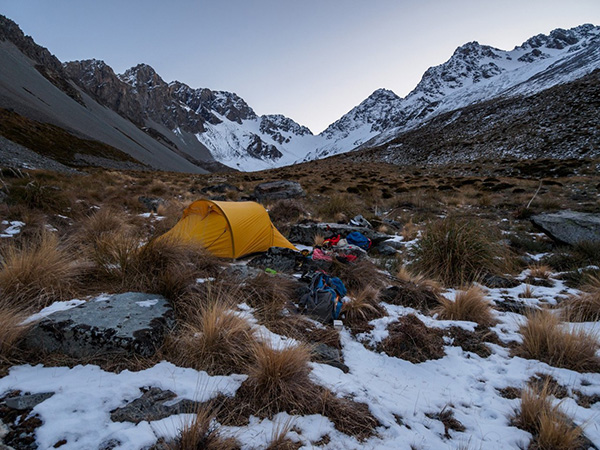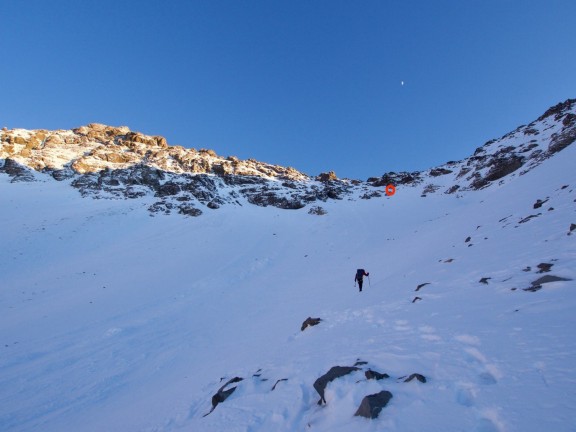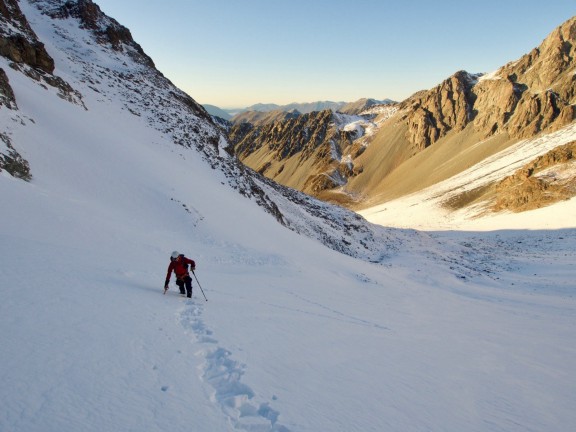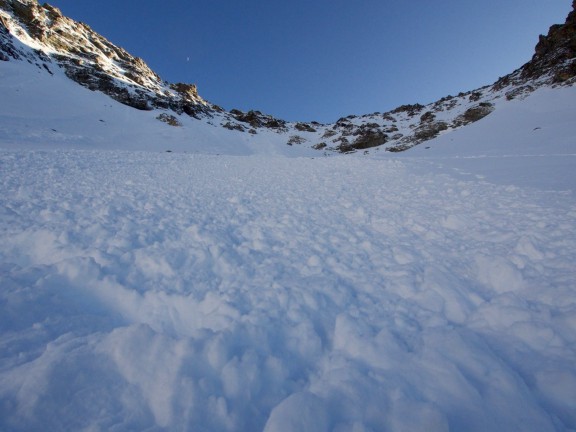A Climber's Lucky Escape
WARNING graphic content
On 14 June 2020 two climbers were caught in an avalanche on the south face of Mt Alma in the Two Thumbs Range, Canterbury. Thankfully, both survived to share their story. Mountain Safety Council (MSC) caught up with one of the climbers to learn more about the events that took place and how other climbers can learn from this incident.
This avalanche incident was reported via the NZ Avalanche Advisory public observation tool, you can see the original observation here.

Camp in Alma Stream. Mt. Alma is to the right of the saddle behind the tent.
The pair have a broad range of experience in the mountains, previously Tom had successfully climbed peaks such as Malte Brun (North and West ridges), Aoraki (Linda Route), Mt Aspiring, Mt Sefton (West Ridge) and Mt Arrowsmith, plus an attempt on Mt Tasman. Earlier in June they’d climbed Mt Jukes (near the Cass Valley) together and Turret Peak in the Rolleston Range. Mt Alma was not the first ascent of the month, nor were the pair new to spending time in the mountains.
In the week leading up to their trip the pair kept a watchful eye on the weather. A combination of fresh snow and others pulling out scuttled their plans for a climb in Arthur’s Pass National Park, so the option of Mt Alma was agreed upon and packing begun late on Friday night. The pair chose Mt Alma as they felt it was east enough of the main divide to miss most of the new snow and hoped for firm conditions on the NE aspects. They decided to leave their avalanche gear behind as they figured the snow cover would still be very thin.

Dawn below Mt. Alma. They were heading for the saddle on the right.
The pair planned to climb Mt Alma either via the NE ridgeline or NE face depending on an assessment of the conditions once on site. The night prior to their attempt they camped at about 1350m in the head of Alma Stream. On the morning of 14 June they broke camp and set off about 6.30am, having decided to attempt the NE ridge.
The snow cover was generally thin and in places they were occasionally post-holing down to the rocks below.
Tom states “In hindsight we were focussed on the NE ridge route and didn’t consider the dangers of getting there well enough. We did not really discuss the avalanche danger of our route up; I think we assumed that the danger was low because of the thin snow cover and rocks anchoring the slope. We did notice debris on other avalanche paths around the basin, but they were not fresh.”
The pair put crampons on half-way up the slope because they were occasionally encountering an icy layer approximately 20–30cm below the surface.

Heading up towards the saddle. The red circle is where they triggered the avalanche.
Tom was following his partner, about 5m behind, when he heard a ‘whumph’ sound. Both climbers began sliding. Tom rolled on to his front in an attempt to self-arrest with his ice axe, but his foot got caught in the debris and he started to tumble out of control. His head was under snow and at times was unable to breathe. Using his arms Tom was trying to stay near the surface of the avalanche, essentially attempting to ‘swim’. Eventually he was able to gain some control and stabilise himself on his bottom with his feet downhill. Hitting another large rock he lost control again and began to tumble, but for a second time he managed to stabilise himself and get back into a sitting position, riding out the avalanche until it stopped some 300m below where Tom had been prior to the slope releasing.

Heading up the slope below the saddle, about 20 minutes before the avalanche.
Thankfully, Tom’s partner, who was also caught, had managed to get himself out of the avalanche much higher up, using a ‘barrel roll’ technique. He watched Tom carry on down tracking his position, knowing he’d be down as quickly as he could to rescue him.
“Once the avalanche stopped, I noticed that I was bleeding from my leg and saw a large cut with skin hanging off. I yelled up to my partner that my leg was hurt and we may need to pull the PLB.”

The resulting injury. Cut to the bone and requiring surgery
When the MSC caught up with Tom only a few days after the avalanche he was recovering in hospital and more than willing to share his story to help other climbers. We asked Tom some questions about his experience.
MSC: Reflecting on the incident, has it put you off climbing?
Tom: I don’t think it has put me off climbing, but it definitely makes me want to learn more about avalanche awareness and snow science. It does spook me a bit to think about other climbs when I may have had close calls without knowing it, and in places with a much worse run-out than this accident.
MSC: What’s been your key learning points? What would you do differently next time, if anything?
Tom: The key learning points I’m taking away from this so far are to not be complacent with a thin snowpack, and to keep continually re-assessing the conditions. We didn’t really assess that we were on a gradually steepening slope, and moving onto a ramp with slightly deeper windblown snow, and that the icy layer we were encountering could make for a dangerous sliding surface, even though there were also shallow rocks.
We were also mostly fixated on the more technical climbing aspect of the route up, i.e. what conditions would be like once we got onto the NE ridge. We didn’t adequately consider the dangers of getting up to the ridge, even though we knew that it had been very cold and shady, so the snow would not be well-consolidated on that slope.
If I could go back again, I would consider safer ways of accessing the ridge, probably by ascending Alma Spur from further down the valley on slightly more north-facing slopes.

Looking back up the avalanche from where they stopped.
Tom and his climbing partner want to express their sincere thanks to the Aoraki/Mt Cook Alpine Cliff Rescue Team and helicopter rescue crew.
The MSC highly recommend carrying avalanche rescue equipment (transceiver, shovel, and probe) at all times when alpine climbing in snow covered terrain.
- Find the latest avalanche advisory at www.avalanche.net.nz
- Ensure you know the basics by completing our free online course
- Take a field course and learn from a professional